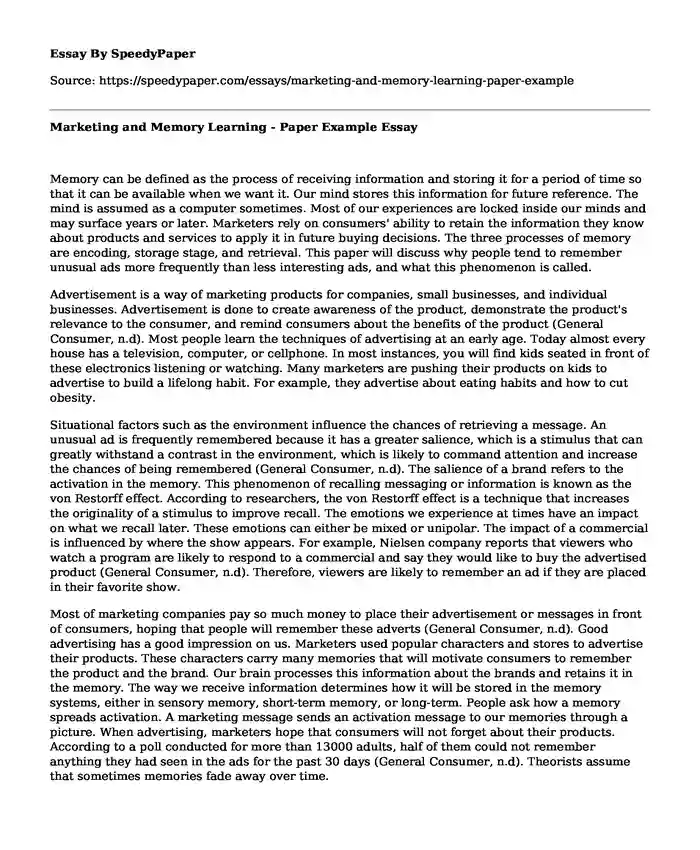
| Type of paper: | Essay |
| Categories: | Learning Company Advertising Marketing |
| Pages: | 3 |
| Wordcount: | 658 words |
Memory can be defined as the process of receiving information and storing it for a period of time so that it can be available when we want it. Our mind stores this information for future reference. The mind is assumed as a computer sometimes. Most of our experiences are locked inside our minds and may surface years or later. Marketers rely on consumers' ability to retain the information they know about products and services to apply it in future buying decisions. The three processes of memory are encoding, storage stage, and retrieval. This paper will discuss why people tend to remember unusual ads more frequently than less interesting ads, and what this phenomenon is called.
Advertisement is a way of marketing products for companies, small businesses, and individual businesses. Advertisement is done to create awareness of the product, demonstrate the product's relevance to the consumer, and remind consumers about the benefits of the product (General Consumer, n.d). Most people learn the techniques of advertising at an early age. Today almost every house has a television, computer, or cellphone. In most instances, you will find kids seated in front of these electronics listening or watching. Many marketers are pushing their products on kids to advertise to build a lifelong habit. For example, they advertise about eating habits and how to cut obesity.
Situational factors such as the environment influence the chances of retrieving a message. An unusual ad is frequently remembered because it has a greater salience, which is a stimulus that can greatly withstand a contrast in the environment, which is likely to command attention and increase the chances of being remembered (General Consumer, n.d). The salience of a brand refers to the activation in the memory. This phenomenon of recalling messaging or information is known as the von Restorff effect. According to researchers, the von Restorff effect is a technique that increases the originality of a stimulus to improve recall. The emotions we experience at times have an impact on what we recall later. These emotions can either be mixed or unipolar. The impact of a commercial is influenced by where the show appears. For example, Nielsen company reports that viewers who watch a program are likely to respond to a commercial and say they would like to buy the advertised product (General Consumer, n.d). Therefore, viewers are likely to remember an ad if they are placed in their favorite show.
Most of marketing companies pay so much money to place their advertisement or messages in front of consumers, hoping that people will remember these adverts (General Consumer, n.d). Good advertising has a good impression on us. Marketers used popular characters and stores to advertise their products. These characters carry many memories that will motivate consumers to remember the product and the brand. Our brain processes this information about the brands and retains it in the memory. The way we receive information determines how it will be stored in the memory systems, either in sensory memory, short-term memory, or long-term. People ask how a memory spreads activation. A marketing message sends an activation message to our memories through a picture. When advertising, marketers hope that consumers will not forget about their products. According to a poll conducted for more than 13000 adults, half of them could not remember anything they had seen in the ads for the past 30 days (General Consumer, n.d). Theorists assume that sometimes memories fade away over time.
Conclusion
In conclusion, the stimulus is used as a basic idea of the underlying branding strategies. Most companies share this approach by creating a brand name and using various associates to market the new item. Learning experiences we get from the environment influence the way we respond to similar situations in the future. Consumers who get a compliment after buying a particular product are likely to buy the product again.
References
Internal influences on consumer behavior. (n.d.). In General consumer.
Cite this page
Marketing and Memory Learning - Paper Example. (2023, Dec 20). Retrieved from https://speedypaper.net/essays/marketing-and-memory-learning-paper-example
Request Removal
If you are the original author of this essay and no longer wish to have it published on the SpeedyPaper website, please click below to request its removal:
- Free Essay: A Case Study of Samsung Employees' Relations
- Free Essay for Students on Cultural Linguistics
- Understanding Student Misconceptions, Free Essay in Education
- Mei Quoran. Essay Example
- Free Essay: The Spread of Bacteria
- Essay Example on Successful Work Strategies
- Governance Policy at Walmart vs Amazon - Paper Example
Popular categories




